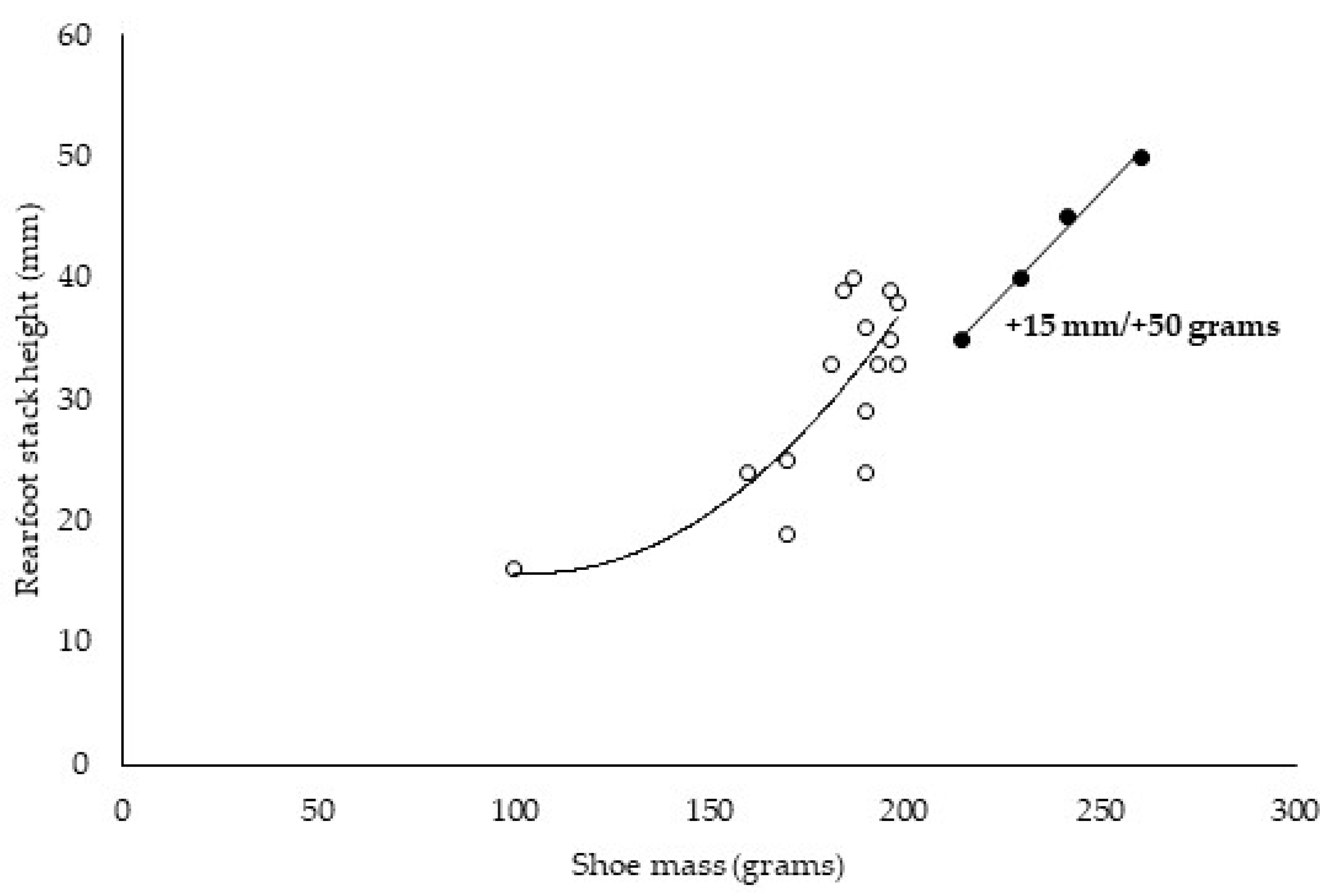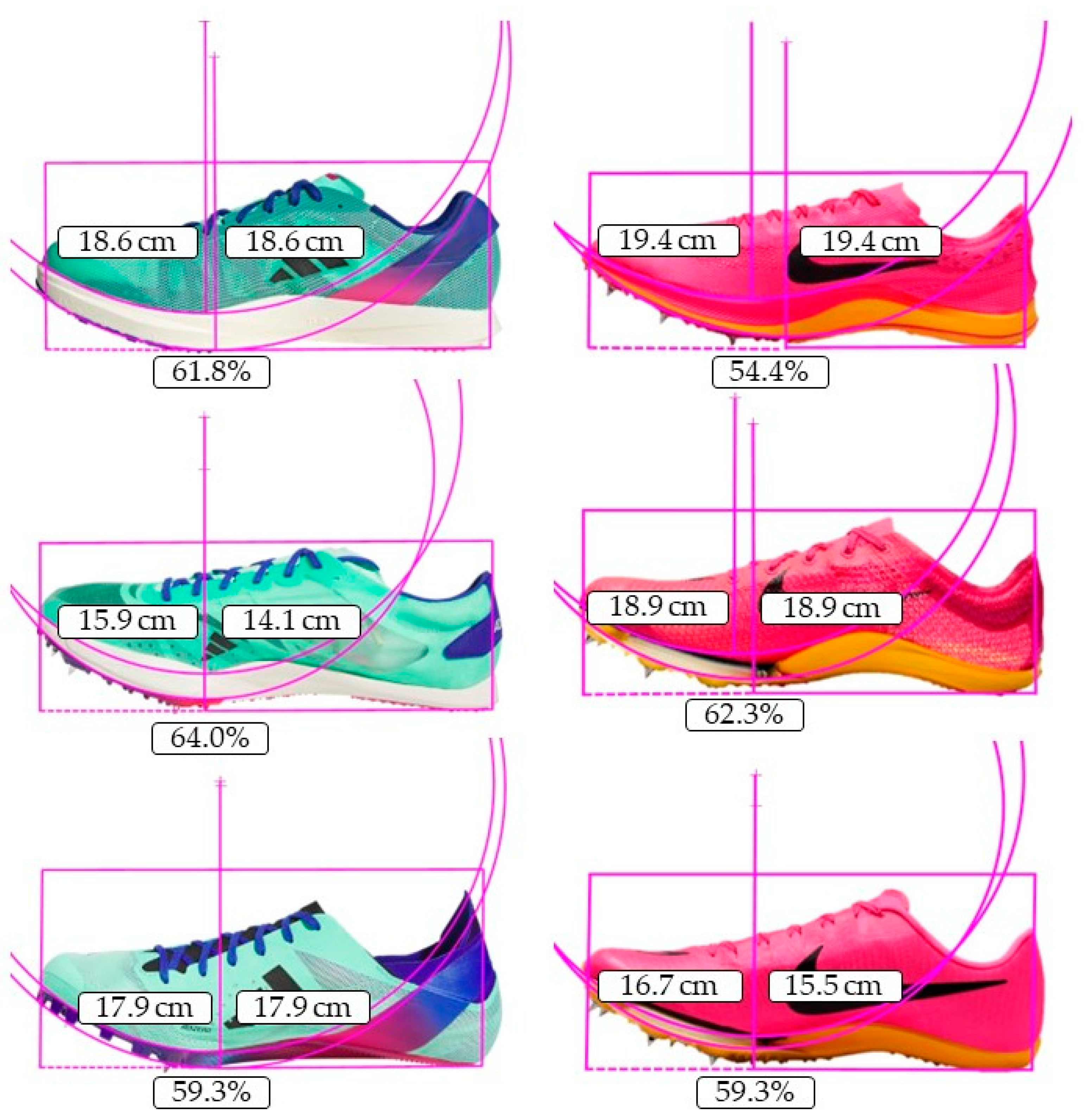A Review of the Potential Effects of the World Athletics Stack Height Regulation on the Footwear Function and Running Performance
Abstract
:1. Introduction
2. Materials and Methods
3. Results
3.1. Effect of the Stack Height on Running Performance
3.2. Effect of the Shoe Mass on Running Performance and Influence of the Stack Height
3.3. Effect of the Midsole Properties on Running Performance and Influence of the Stack Height
3.4. Effect of the Teeter-Totter Effect on Running Performance and Influence of the Stack Height
4. Discussion
4.1. Effect of the Stack Height on Running Performance
4.2. Effect of the Shoe Mass on Running Performance and Influence of the Stack Height
4.3. Effect of the Midsole Properties on Running Performance and Influence of the Stack Height
4.4. Effect of the Teeter-Totter Effect on Running Performance and Influence of the Stack Height
5. Conclusions
6. Future Directions
Funding
Conflicts of Interest
References
- Joyner, M.J.; Ruiz, J.R.; Lucia, A. The two-hour marathon: Who and when? J. Appl. Physiol. 2011, 110, 275–277. [Google Scholar] [CrossRef] [PubMed]
- Bermon, S.; Garrandes, F.; Szabo, A.; Berkovics, I.; Adami, P.E. Effect of advanced shoe technology on the evolution of road race times in male and female elite runners. Front. Sports Act. Living 2021, 3, 653173. [Google Scholar] [CrossRef] [PubMed]
- Jones, A.M.; Kirby, B.S.; Clark, I.E.; Rice, H.M.; Fulkerson, E.; Wylie, L.J.; Wilkerson, D.P.; Vanhatalo, A.; Wilkins, B.W. Physiological demands of running at 2-hour marathon race pace. J. Appl. Physiol. 2021, 130, 369–379. [Google Scholar] [CrossRef]
- Lundby, C.; Robach, P. Performance enhancement: What are the physiological limits? Physiology 2015, 30, 282–292. [Google Scholar] [CrossRef] [PubMed]
- Poole, D.C.; Burnley, M.; Vanhatalo, A.; Rossiter, H.B.; Jones, A.M. Critical power: An important fatigue threshold in exercise physiology. Med. Sci. Sports Exerc. 2016, 48, 2320–2334. [Google Scholar] [CrossRef] [PubMed]
- Hoogkamer, W.; Kipp, S.; Frank, J.H.; Farina, E.M.; Luo, G.; Kram, R. A comparison of the energetic cost of running in marathon racing shoes. Sports Med. 2018, 48, 1009–1019. [Google Scholar] [CrossRef]
- Snyder, K.L.; Hoogkamer, W.; Triska, C.; Taboga, P.; Arellano, C.J.; Kram, R. Effects of course design (curves and elevation undulations) on marathon running performance: A comparison of Breaking 2 in Monza and the INEOS 1:59 Challenge in Vienna. J. Sports Sci. 2021, 39, 754–759. [Google Scholar] [CrossRef]
- Rodrigo-Carranza, V.; González-Mohíno, F.; Santos-Concejero, J.; González-Ravé, J.M. Impact of advanced footwear technology on elite men’s in the evolution of road race performance. J. Sports Sci. 2022, 40, 2661–2668. [Google Scholar] [CrossRef]
- World Athletics. Technical Rules. Available online: https://www.worldathletics.org/about-iaaf/documents/book-of-rules (accessed on 1 September 2023).
- Burns, G.T.; Tam, N. Is it the shoes? A simple proposal for regulating footwear in road running. Br. J. Sports Med. 2020, 54, 439–440. [Google Scholar] [CrossRef]
- Frederick, E.C. No evidence of a performance advantage attributable to midsole thickness. Footwear Sci. 2020, 12, 1–2. [Google Scholar] [CrossRef]
- Hoogkamer, W. More isn’t always better. Footwear Sci. 2020, 12, 75–77. [Google Scholar] [CrossRef]
- Nigg, B.M.; Cigoja, S.; Nigg, S.R. Effects of running shoe construction on performance in long distance running. Footwear Sci. 2020, 12, 133–138. [Google Scholar] [CrossRef]
- Nigg, B.M.; Cigoja, S.; Nigg, S.R. Teeter-totter effect: A new mechanism to understand shoe-related improvements in long-distance running. Br. J. Sports Med. 2021, 55, 462–463. [Google Scholar] [CrossRef]
- Rodrigo-Carranza, V.; González-Mohíno, F.; Santos del Cerro, J.; Santos-Concejero, J.; González-Ravé, J.M. Influence of advanced shoe technology on the top 100 annual performances in men’s marathon from 2015 to 2019. Sci. Rep. 2021, 11, 22458. [Google Scholar] [CrossRef] [PubMed]
- Honert, E.C.; Mohr, M.; Lam, W.K.; Nigg, S. Shoe feature recommendations for different running levels: A Delphi study. PLoS ONE 2020, 15, e0236047. [Google Scholar] [CrossRef]
- Barrons, Z.B.; Wannop, J.W.; Stefanyshyn, D.J. The influence of footwear midsole thickness on running biomechanics and running economy in female and male runners. Footwear Sci. 2023, 15, 155–160. [Google Scholar] [CrossRef]
- Bertschy, M.; Lino, H.; Healey, L.; Hoogkamer, W. Effects of midsole stack height and foam on the metabolic cost of running. Footwear Sci. 2023, 15, S180–S181. [Google Scholar] [CrossRef]
- Rodrigo-Carranza, V.; González-Mohíno, F.; Santos-Concejero, J.; González-Ravé, J.M. Influence of shoe mass on performance and running economy in trained runners. Front. Physiol. 2020, 11, 573660. [Google Scholar] [CrossRef]
- Franz, J.R.; Wierzbinski, C.M.; Kram, R. Metabolic cost of running barefoot versus shod: Is lighter better? Med. Sci. Sports Exerc. 2012, 44, 1519–1525. [Google Scholar] [CrossRef]
- Hoogkamer, W.; Kipp, S.; Spiering, B.A.; Kram, R. Altered running economy directly translates to altered distance-running performance. Med. Sci. Sports Exerc. 2016, 48, 2175–2180. [Google Scholar] [CrossRef]
- Jakob-Andersen, J. Runrepeat. Available online: https://runrepeat.com/ (accessed on 24 August 2023).
- Tung, K.D.; Franz, J.R.; Kram, R. A test of the metabolic cost of cushioning hypothesis during unshod and shod running. Med. Sci. Sports Exerc. 2014, 46, 324–329. [Google Scholar] [CrossRef] [PubMed]
- Worobets, J.; Tomaras, E.; William Wannop, J.; Stefanyshyn, D. Running shoe cushioning properties can influence oxygen consumption. Footwear Sci. 2013, 5, S75–S76. [Google Scholar] [CrossRef]
- Joubert, D.P.; Jones, G.P. A comparison of running economy across seven highly cushioned racing shoes with carbon-fibre plates. Footwear Sci. 2022, 14, 71–83. [Google Scholar] [CrossRef]
- Puig-Diví, A.; Escalona-Marfil, C.; Padullés-Riu, J.M.; Busquets, A.; Padullés-Chando, X.; Marcos-Ruiz, D. Validity and reliability of the Kinovea program in obtaining angles and distances using coordinates in 4 perspectives. PLoS ONE 2019, 14, e0216448. [Google Scholar] [CrossRef]
- Nigg, B.M.; Segesser, B. Biomechanical and orthopedic concepts in sport shoe construction. Med. Sci. Sports Exerc. 1992, 24, 595–602. [Google Scholar] [CrossRef] [PubMed]
- Stefanyshyn, D.J.; Nigg, B.M. Energy aspects associated with sport shoes. Sportverletz. Sportschaden 2000, 14, 82–89. [Google Scholar] [CrossRef] [PubMed]
- Gray, A.; Andrews, M.; Waldron, M.; Jenkins, D. A model for calculating the mechanical demands of overground running. Sports Biomech. 2020; Online ahead of print. [Google Scholar] [CrossRef]
- Farina, E.M.; Haigh, D.; Luo, G. Creating footwear for performance running. Science 2019, 10, 179–187. [Google Scholar] [CrossRef]
- Sichting, F.; Holowka, N.B.; Hansen, O.B.; Lieberman, D.E. Effect of the upward curvature of toe springs on walking biomechanics in humans. Sci. Rep. 2020, 10, 14643. [Google Scholar] [CrossRef]
- Stearne, S.M.; McDonald, K.A.; Alderson, J.A.; North, I.; Oxnard, C.E.; Rubenson, J. The foot’s arch and the energetics of human locomotion. Sci. Rep. 2016, 6, 19403. [Google Scholar] [CrossRef]
- Fuller, J.T.; Bellenger, C.R.; Thewlis, D.; Tsiros, M.D.; Buckley, J.D. The effect of footwear on running performance and running economy in distance runners. Sports Med. 2015, 45, 411–422. [Google Scholar] [CrossRef]
- Ruiz-Alias, S.A.; Molina-Molina, A.; Soto-Hermoso, V.M.; García-Pinillos, F. A systematic review of the effect of running shoes on running economy, performance and biomechanics: Analysis by brand and model. Sports Biomech. 2023, 22, 388–409. [Google Scholar] [CrossRef]
- Healey, L.; Bertschy, M.; Kipp, S.; Hoogkamer, W. Can we quantify the benefits of “super spikes” in track running? Sports Med. 2022, 52, 1211–1218. [Google Scholar] [CrossRef] [PubMed]
- Barnes, K.R.; Kilding, A.E. Running economy: Measurement, norms, and determining factors. Sports Med. Open 2015, 1, 1–15. [Google Scholar] [CrossRef] [PubMed]
- Stefanyshyn, D.J.; Nigg, B.M. Influence of midsole bending stiffness on joint energy and jump height performance. Med. Sci. Sports Exerc. 2000, 32, 471. [Google Scholar] [CrossRef] [PubMed]
- Stefanyshyn, D.; Fusco, C. Athletics: Increased shoe bending stiffness increases sprint performance. Sports Biomech. 2004, 3, 55–66. [Google Scholar] [CrossRef] [PubMed]
- Knopp, M.; Muñiz-Pardos, B.; Wackerhage, H.; Schönfelder, M.; Guppy, F.; Pitsiladis, Y.; Ruiz, D. Variability in Running Economy of Kenyan World-Class and European Amateur Male Runners with Advanced Footwear Running Technology: Experimental and Meta-analysis Results. Sports Med. 2023, 6, 1255–1271. [Google Scholar] [CrossRef]
- Nigg, B.M.; Baltich, J.; Hoerzer, S.; Enders, H. Running shoes and running injuries: Myth busting and a proposal for two new paradigms: ‘Preferred movement path’ and ‘comfort filter’. Br. J. Sports Med. 2015, 49, 1290–1294. [Google Scholar] [CrossRef]
- Madden, R.; Sakaguchi, M.; Tomaras, E.K.; Wannop, J.W.; Stefanyshyn, D. Forefoot bending stiffness, running economy and kinematics during overground running. Footwear Sci. 2016, 8, 91–98. [Google Scholar] [CrossRef]




| Event | 2019–2022 | 2022–2024 | 2024 |
|---|---|---|---|
| <800 m | 20 mm | 20 mm | 20 mm |
| ≥800 m | 25 mm | 25 mm | 20 mm |
| Road | 40 mm | 40 mm | 40 mm |
| Cross Country | 25 mm spike shoe or non-spike shoe | 20 mm spike shoe or 40 mm non-spike shoe | 20 mm spike shoe or 40 mm non-spike shoe |
Disclaimer/Publisher’s Note: The statements, opinions and data contained in all publications are solely those of the individual author(s) and contributor(s) and not of MDPI and/or the editor(s). MDPI and/or the editor(s) disclaim responsibility for any injury to people or property resulting from any ideas, methods, instructions or products referred to in the content. |
© 2023 by the authors. Licensee MDPI, Basel, Switzerland. This article is an open access article distributed under the terms and conditions of the Creative Commons Attribution (CC BY) license (https://creativecommons.org/licenses/by/4.0/).
Share and Cite
Ruiz-Alias, S.A.; Jaén-Carrillo, D.; Roche-Seruendo, L.E.; Pérez-Castilla, A.; Soto-Hermoso, V.M.; García-Pinillos, F. A Review of the Potential Effects of the World Athletics Stack Height Regulation on the Footwear Function and Running Performance. Appl. Sci. 2023, 13, 11721. https://doi.org/10.3390/app132111721
Ruiz-Alias SA, Jaén-Carrillo D, Roche-Seruendo LE, Pérez-Castilla A, Soto-Hermoso VM, García-Pinillos F. A Review of the Potential Effects of the World Athletics Stack Height Regulation on the Footwear Function and Running Performance. Applied Sciences. 2023; 13(21):11721. https://doi.org/10.3390/app132111721
Chicago/Turabian StyleRuiz-Alias, Santiago A., Diego Jaén-Carrillo, Luis Enrique Roche-Seruendo, Alejandro Pérez-Castilla, Víctor M. Soto-Hermoso, and Felipe García-Pinillos. 2023. "A Review of the Potential Effects of the World Athletics Stack Height Regulation on the Footwear Function and Running Performance" Applied Sciences 13, no. 21: 11721. https://doi.org/10.3390/app132111721
APA StyleRuiz-Alias, S. A., Jaén-Carrillo, D., Roche-Seruendo, L. E., Pérez-Castilla, A., Soto-Hermoso, V. M., & García-Pinillos, F. (2023). A Review of the Potential Effects of the World Athletics Stack Height Regulation on the Footwear Function and Running Performance. Applied Sciences, 13(21), 11721. https://doi.org/10.3390/app132111721










